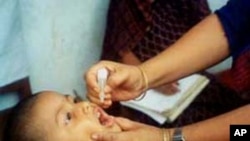Efforts to eradicate polio have been frustrated by a variety of factors, and unlike smallpox, the disease has defied long-running and expensive efforts to wipe it out. Now, a new study indicates that one of several polio vaccines can be effective at one-fifth the dose, cutting vaccination costs dramatically.
There are several different kinds of polio vaccine. The oral vaccine – made with a weakened, live virus – has been used extensively in polio eradication efforts. World Health Organization polio official Roland Sutter says it's cheap and easy to use, "But it has one major side effect," he said. "It can rarely, very rarely, cause what we call vaccine-induced paralytic polio myelitis."
That's the very disease the vaccine is intended to prevent. So in countries where polio has already been eradicated, the vaccine of choice uses a killed form of the polio virus. But Sutter says that vaccine has a different problem - its cost.
"The inactivated polio virus vaccine, IPV, is currently quite expensive. The cheapest way we possibly can get it now is about $3 a dose. And so, this compares to 15 cents for the oral polio virus vaccine."
There are several ways to bring down the price per dose. Manufacturing can be moved to developing countries, where costs are lower. The production process can be made more efficient. Extra ingredients, called adjuvants, can be added to the vaccine to make it more effective. Those are all on the table, but maybe the easiest way to cut the cost of vaccination is to reduce the amount of vaccine.
That's the subject of new research by Roland Sutter and colleagues from public health institutes in the U.S. and the Netherlands, and the Ministry of Health in Oman.
In their study, one group of children in Oman was vaccinated with the usual dose of the inactivated polio vaccine, while another group was vaccinated using only one-fifth the usual amount.
The ones who got the smaller dose were fully protected, even though the vaccine prompted production of fewer antibodies than with the full dose.
"So these lower levels are actually still quite good and will protect the child from polio," he said.
But Sutter cautions that reducing the amount of vaccine used by 80 percent doesn't lower the cost of vaccination by 80 percent. The actual vaccine amounts to only one-third or less of the cost of a vaccination program. But still, he says, it's a "huge step forward" in the ongoing battle against a crippling disease.
Sutter and his colleagues describe their research in the New England Journal of Medicine.





